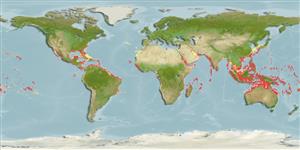Gastropoda |
Littorinimorpha |
Ranellidae | Cymatiinae
Environment: milieu / climate zone / djupintervall / distribution range
Ekologi
; djupintervall 0 - 60 m (Ref. 83934). Tropical; 40°N - 24°S, 180°W - 180°E
Circumtropical: from Japan to Pitcairn Islands.
Length at first maturity / Size / Weight / Age
Könsmognad: Lm ? range ? - ? cm Max length : 12.0 cm ShH hane/ej könsbestämd; (Ref. 349); common length : 8.0 cm SHL hane/ej könsbestämd; (Ref. 349)
Locally collected for food and for the shell (Ref. 349). Common under coral slabs. Occurs at the low tide mark (Ref. 349). It is also found offshore, on coral reefs, cienaga facies, and mangroves, particularly on pilings, cirripeds, coral, mud, rock, sand, seagrass, and shell habitats (Ref. 83934).
Life cycle and mating behavior
Könsmognad | Reproduktion | Lek | Eggs | Fecundity | Larvae
Members of the order Neotaenioglossa are mostly gonochoric and broadcast spawners. Life cycle: Embryos develop into planktonic trocophore larvae and later into juvenile veligers before becoming fully grown adults.
Poutiers, J.M. 1998 Gastropods. p. 363-648. In Carpenter, K. E. and V. H. Niem. 1998. FAO species identification guide for fishery purposes. The living marine resources of the Western Central Pacific. Volume 1. Seaweeds, corals, bivalves, and gastropods. Rome, FAO. (Ref. 349)
IUCN Red List Status
(Ref. 130435: Version 2025-1)
CITES status (Ref. 108899)
Not Evaluated
Not Evaluated
Threat to humans
Human uses
| FishSource |
Verktyg
Ytterligare information
PhysiologySyreförbrukning
Human RelatedStamps, coins, misc.
Internet-källor
Estimates based on models
Preferred temperature
(Ref.
115969): 24.8 - 29.3, mean 28.5 (based on 3310 cells).
Fishing Vulnerability
Low vulnerability (10 of 100).
Price category
Unknown.
